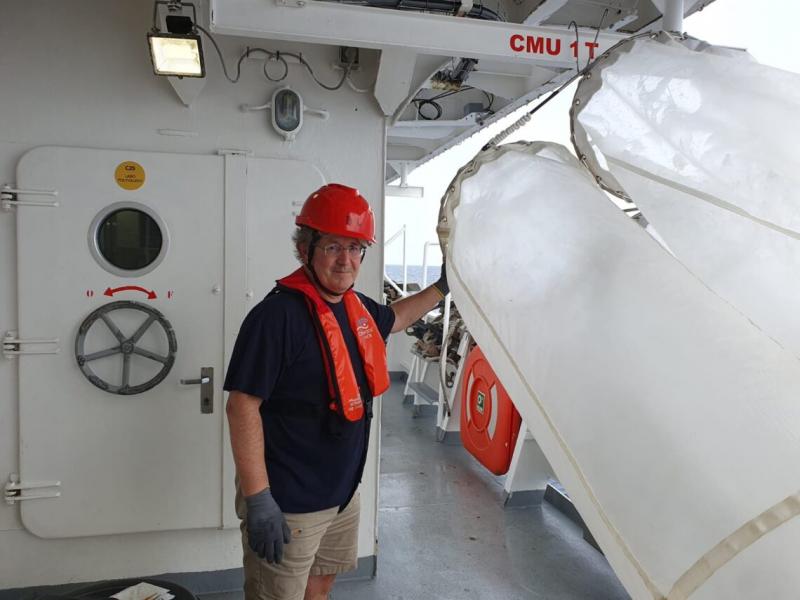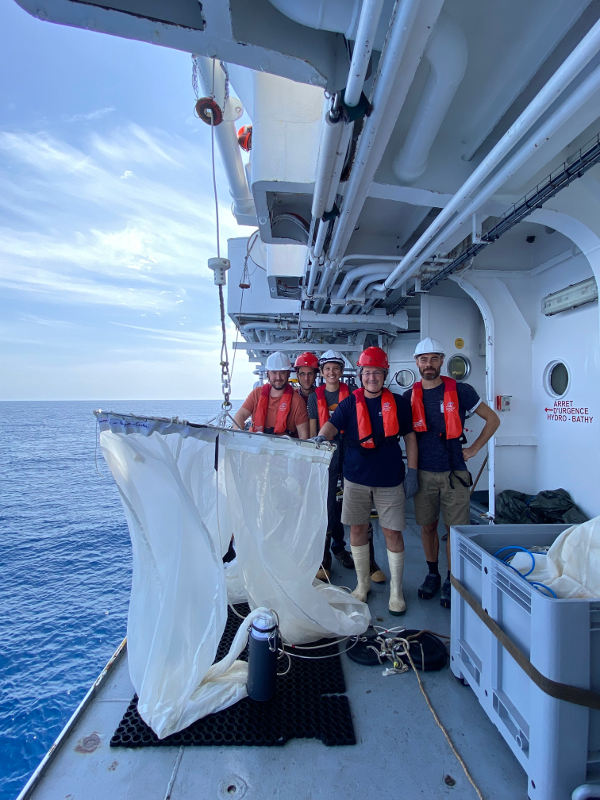Exploring the links between fine-scale structures and zooplankton dispersal
François Carlotti is the leader of BioSWOT-Med's WP4 "From zooplankton to higher trophic levels", which aims to understand how fine-scale ocean structures can affect the distribution of metazoan organisms, from the smallest (zooplankton) to the largest (cetaceans). Here he describes the hypothesis being tested to explain the distribution of different groups of zooplankton in different bodies of water.

François Carlotti with the zooplankton net on board the R/V L'Atalante
RESEARCH THEMES - François Carlotti is a researcher at the CNRS and works at the Institut Méditerranéen d'Océanographie. He is a biological oceanographer with a particular interest in the structure and functioning of pelagic marine ecosystems and their responses to climate forcing and anthropogenic impacts. As part of the BioSWOT-Med campaign, he is the coordinator of WP4 "From zooplankton to higher trophic levels".
What are your research interests outside BioSWOT-Med?
I am a biological oceanographer with a keen interest in the structure and functioning of pelagic marine ecosystems and their responses to climate forcing and anthropogenic impacts. My research focuses on zooplankton, which play a central role in all pelagic food webs, and extends to adjacent trophic levels through research into bottom-up and top-down forcing processes. My main approaches are observation with different types of analysis of collected samples (zooplankton imaging, diversity, size structure, physiological processes) and in situ sensor data, as well as mathematical modelling. My main interests are (1) the importance of couplings between hydrodynamic processes, their biogeochemical functioning and the behaviour of organisms in the variability of zooplankton distributions; (2) the contribution of zooplankton to trophic and biogeochemical flows within ecosystems. This corresponds to the lines of research of the Future Oceans - IMBeR international programme. My research extends from the polar regions to the tropics and the Mediterranean, and from the open sea to coastal areas. Over the last ten years, I have taken part in the main biogeochemical campaigns in the Mediterranean as part of the MISTRALS-MERMEX programme.
As part of the BioSWOT-Med campaign, you are the coordinator of WP 4, which studies zooplankton down to the upper trophic levels. You have several research objectives. Can you tell us about them?
Our work package 4 is entitled "From zooplankton to higher trophic levels". Our overall objective in BioSWOT-Med is to understand how fine-scale ocean structures can affect the distribution of metazoan organisms, from the smallest (zooplankton) to the largest (cetaceans). In practice, we focus mainly on the first trophic levels (zooplankton and their planktonic predators), but we also opportunistically note whether larger animals (cetaceans, basking sharks, etc.) are present in the vicinity.
This overall objective can be broken down into different scientific objectives:
- Characterise the distributions of mesozooplankton and macrozooplankton/micronekton in horizontal and vertical dimensions (from the mesoscale to the fine scale);
- Define the structural and functional variations of zooplankton communities in bodies of water and in the frontal region;
- Estimating the impact of mesozooplankton grazing on the phytoplankton community;
- Estimating the contribution of mesozooplankton to carbon fluxes ;
During the BioSWOT-Med cruise, samples will be taken at different depths, day and night. Why should we do this?
All these metazoan organisms can move through the water column, and over great distances in relation to their size. Even zooplanktonic organisms (initially thought to be unable to escape currents) have very great vertical swimming abilities, particularly when they migrate vertically between day and night. The main reason for this is that many of them descend during the day to the depths of the ocean (up to hundreds of metres) where it is darker to escape visual predators, but rise to the surface at night to feed on the phytoplankton and associated micro-organisms that have developed there in the light during the day. This process, known as diurnal vertical migration, is the largest animal migration on Earth. We will therefore try to understand how mesoscale surface structures can impact or modulate these migrations, and whether they induce differences in the migration process depending on the species.
In addition to observations of changes in zooplankton distribution between day and night, we will measure the actual grazing of zooplankton between day and night and attempt to quantify the additional impact of migrating zooplankton on the phytoplankton stock and associated microbial community during the night using large-scale mesocosm experiments.
One of the hypotheses of your research is that different groups of zooplankton species are found in different bodies of water. Can you explain this?
Zooplanktonic organisms have very varied diets. Even among copepods, a group of crustaceans that dominates zooplankton, there are herbivores, omnivores and carnivores. Copepods are selective feeders and the distribution, size, behaviour and biochemical quality of their prey (including phytoplankton and smaller zooplankton) determine the selection process. As the nature and distribution of prey are themselves conditioned by fine ocean structures, it is expected that zooplankton assemblages in these structures will also be affected.
What hypothesis could explain the impact of fine-scale structures on the distribution of zooplankton?
Since the 1990s (GLOBEC international programme), observations have been accumulating showing that zooplankton develop particularly well in mesoscale structures. New physical and biological instruments (platforms and sensors) now make it possible to explore this subject on scales smaller than the mesoscale. The observations made during the BioSWOT-Med campaign, in particular those of the Zooglider, will help to confirm the links between fine-scale structures and zooplankton patchiness. The hypothesis that we wish to test in conjunction with WP3 (Biogeochemistry and microbial dynamics) and WP5 (Plankton genomics) is that the structure of autotrophic and microbial communities stimulated by a fine-scale physical structure is reflected at the level of zooplankton consumers. Thus, the mosaic of physical structures corresponds to the mosaics of each of the first trophic levels.
Contact us: Tosca Ballerini
More information

Researchers ready to deploy the zooplankton net at sea.




